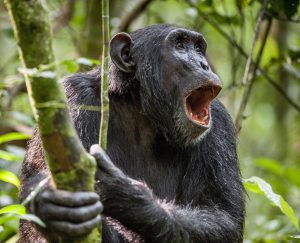
It usually starts with one; one dead animal, one sick individual, one case that a doctor thinks is unusual. These are all ways that a new disease makes its presence known. In the case of Bacillus cereus biovar anthracis, it started with a dead chimpanzee (1).
The wild western chimpanzee was found dead in Côte d’Ivoire in 2001. An investigation led by scientists from the Robert Koch Institute in Berlin identified the pathogenic cause of death to be an atypical B. cereus isolate that caused an anthrax-like disease.
Anthrax is a common, and often lethal, disease in livestock and wild animal populations that occasionally causes infections in humans. It is caused by Bacillus anthracis, which is defined as a clade with in the B. cereus sensu lato group that has low genomic diversity and carries the two virulence plasmids, pXO1 and pXO2.
The pathogen that the scientists isolated from the Côte d’Ivoire chimpanzee wasn’t B. anthracis though, instead it was a form of the related bacterium, B. cereus, with some important differences. This strain of B. cereus carried plasmids that were almost identical to the pXO1 and pXO2 virulence plasmids found in B. anthracis. This atypical form of B. cereus, designated Bacillus cereus biovar anthracis (B. cereus bv anthracis), was a phenotypic blend of B. cereus and B. anthracis.
As highlighted in a paper recently published in PLoS Neglected Tropical Diseases (1), the Côte d’Ivoire chimpanzee was not an isolated case, a second chimp was found in Côte d’Ivoire in 2002, followed by wild central chimpanzees and a western lowland gorilla in Cameroon in 2004 and 2006. In early 2012 goats from a forest town in the democratic Republic of Congo tested positive for B. cereus bv anthracis. Later that year, an elephant and a chimpanzee where found dead in the Dzanga-Ndoki National Park in the Central African Republic. In early 2013, a western lowland gorilla was found in the same area. The gorilla, part of a closely monitored group, had shown no signs of illness the day before. The gorilla, the elephant and the chimpanzee were all found within a radius of 5 kilometers.
Phylogenomic analysis of these B. cereus bv anthracis strains showed that they all belonged to single chromosomal clade that is distinct from that of B. anthracis even though they carry the pXO1 and pXO2 plasmids. A comparison of microbiologic properties showed that the B. cereus bv anthracis strains shared properties of both B. anthracis and B. cerus. For example, the B. cereus bv anthracis strains all were non-haemolytic like B. anthracis but are resistant to the gamma-phage like B. cereus. All the strains except the one isolated from goats were motile (like B. cereus). Only the strain isolated from the two dead chimpanzees in Côte d’Ivoire was sensitive to Penicillin G.
The geographic locations where infection was identified shows that B. cereus bv anthracis has spread throughout much of tropical Africa, but there is no indication that it has spread beyond this region. The diversity of the infected species suggest that it can infect a variety of domestic and wild animals. The authors identified a phylogeographic pattern that suggest this clade has existed for quite a while and eliminates the possibility that this is a rapid expansion of a single clone.
There remains a list of things we don’t know about B. cereus bv anthracis, including: Is it transmitted any differently than B. cereus, and is there a biological reason why its distribution is limited to sub-Sahara Africa while B. anthracis is found worldwide?
The authors note that the practice of handling and eating both wild and domestic animals that are found dead is common in this area, and could leave people vulnerable to infection with B. cereus bv anthracis. They further note that the current diagnostic criteria for anthrax-like disease would likely not identify B. cereus bv anthracis infections. Only time will tell us if B. cereus bv anthracis is a new or emerging pathogenic threat to the population of sub-Sahara Africa or if it will remain a relatively anonymous cousin to the better known B. anthracis.
Reference
- Leendertz, F.H. et al. (2016) Bacillus cereus Biovar Anthracis Causing Antrhax in Sub-Saharan Africa— Chromosomal Monophyly and Broad Geographic Distribution. PLoS Negl. Trop. Dis. 10(9): e0004923. Accessed September 20, 2016.

I find these stories fascinating. There’s a really good book I recommend for those interested in the subject, “Spillover” by David Quammen.